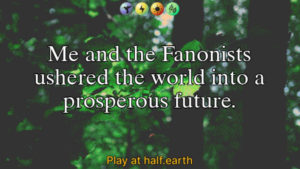
“People are ecstatic” as delegates from the world’s bioregions gather in Raqqa for 2065’s planning session. Although the social-ecological transition is far from over, celebration is understandable. Smokestacks, prisons, slaughterhouses, and warfare are all relics of the past. Leisure time is abundant, and living standards are universally high. The world’s air is fresher than it’s been in centuries, as is the food which is overwhelmingly local, organic, and, yes, vegan. The planet is cooling and will soon stabilize comfortably within 1 degree Celsius of pre-industrial levels. Biodiversity is flourishing, especially in the roughly three-quarters of habitable land that’s protected as wilderness under Indigenous and local communities’ guidance.
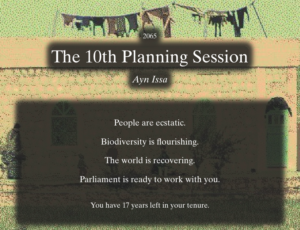
This is the future I achieved in the new digital card game based on Half-Earth Socialism by Troy Vettese and Drew Pendergrass. Like the book–which I’ve reviewed for the upcoming New Politics issue–the game contains a healthy amount of whimsy and humor, with options to increase general happiness through “Champagne socialism” and with anti-vegan extremists forming a “Leather Underground.” When my sixth-grade students caught me playing the game, one described it as “Pokémon for adults.” Although it proved too technical to hold most of these twelve year-olds’ interest for long, one student played it through all the way. (He seemed to take equal delight in endings where the Earth was saved and endings where it was destroyed. Should I be worried?) I could easily see high-school and college instructors including this game in their lessons on climate science.
After all, the game incorporates serious climate modeling designed in large part by the ecologist and engineer Spencer Roberts who I interviewed last fall. Given his convincing critiques of animal agriculture and capitalist greenwashing, I’m not surprised that this game offers little incentive to adopt destructive regenerative-ranching, nuclear-fusion, ocean-fertilization, and cloud brightening technologies. However, I learned during the interview that Roberts is much less of a Luddite than I am. Perhaps that’s why it’s possible to get high scores by adopting techniques I’d oppose in real life, such as vertical farming, carbon-negative concrete, bioengineered-algae fuels, wooden skyscrapers, biochar, and direct air capture.
I wanted to see if it was possible to avoid these risky technologies and still achieve the game’s goals of stabilizing warming below 1 degree, ending biodiversity threats, and maximizing human happiness. Yes, it’s possible, although I haven’t been able to do so before 2080. (I’m not counting those few random times when the game supposes an unrealistically low climate sensitivity. You’ll know this happens when warming goes down to 1 degree or lower in 2025, instead of going up to 1.4 degrees.)
The main obstacles to achieving success decades earlier are political rather than technological. There are a limited number of “political capital” points you can spend on various solutions each round. Increasing the number of points would make the game less challenging but might more closely resemble a revolutionary situation where consciousness has been sufficiently transformed to render once “utopian” objectives feasible. It would definitely enable the player to unlock the crucial “Degrowth in developed areas” and “Global demilitarization” cards much earlier.
Within the parameters of the game, I couldn’t implement anything as ambitious as the Total Liberation pathway I recently proposed in the Green Theory & Praxis Journal. But I tried my best to enact, as rapidly as the game would allow, a transition to degrowth, veganism, and 100% (locally-controlled, decentralized) wind-and-solar energy. This trajectory quickly won me the strong hostility of the game’s Accelerationists and Consumerists, and a cold reception from the Malthusians. On the other hand, I won the approval of the Animal Liberationists, Ecofeminists, Environmentalists, Fanonists, and Utopians.
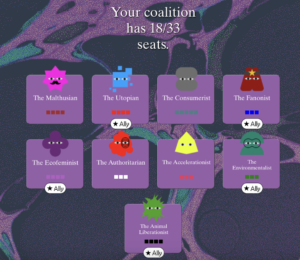
Here’s are some highlights of what I was able to accomplish:
- Abolish nuclear power (by 2025)
- Restore Indigenous sovereignty (by 2030)
- Phase out hydroelectricity (by 2040)
- Achieve net-negative emissions (by 2045)
- Phase out fossil fuels and bioenergy (by 2050)
- Global demilitarization (by 2055)
- Limit warming to 1 degree (by 2075)
The Animal Liberationists were thrilled that society abolished zoos, non-Indigenous hunting, exotic animal trading, and, by 2055, animal agriculture. Although the game seems to require a small amount of cellular meat production in order to eliminate the last vestiges of livestock farming, I don’t see why real-life populations couldn’t turn to lower-tech sources of protein, namely legumes. I’ve previously expressed doubts about the viability of lab-grown meat, especially if it’s going to be produced without fetal bovine serum (procured from slaughter). Indeed, the game’s cellular meat never became a large part of the solution, only producing 5 percent of the meat quantities that humanity consumes today. By the time the technology became available, the world’s animal consumption had already declined by 75 percent and was continuing to decrease even further. The “Vegetarian” and “Vegan” cards proved far more important than the “Cellular meat” card.
In the game as well as reality, it’s a solid principle to make reducing a greater priority than replacing. The “reduce-reuse-recycle” order of priorities is well known, and energy’s (less catchy) corollary is “conservation-efficiency-clean renewables.” Rather than building a fleet of private electric vehicles, my virtual society rapidly decreased the number of cars on the road and banned them outright by 2035. People didn’t seem to mind the ban, since we’d already been expanding walkways, bike paths, and bus routes for over a decade.
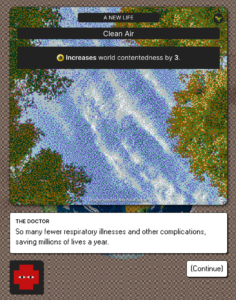
A rapid roll-out of green hydrogen, generated from wind- and solar-powered electrolysis, was indispensable for the energy transition in the 2030s. However, because green hydrogen requires a lot of energy to produce, it only served as a real solution in the context of drastically reducing fuel usage for heating and transportation. The “Mass electrification” card was essential, since producing combustion-free electricity is way easier than producing combustion-free fuel. Although next-generation solar panels helped increase the efficiency of renewable energy, they didn’t become available until well after fossil fuels had been phased out of electricity production.
Since farmers already produce enough food to feed 12 to 14 billion people, eliminating hunger was mainly a matter of redirecting crops to local plates. Still, agroecology has proven remarkably effective at increasing yields, and non-biotech research has been able to produce perennial and drought-resistant crop varieties. As explained in Half-Earth Socialism’s appendix, Vettese and Pendergrass cautiously predict that soil-restoring methods of regenerative agriculture won’t become fully carbon-neutral, let alone carbon-negative. But regenerative farming nonetheless reduced the game’s agricultural emissions to managable levels.

Global warming hit a peak of 1.5 degrees in 2030, and declined to 1.4 within the decade. By 2080, with warming down to 0.9 degrees, only 22 of percent land was being used for infrastructure and agriculture. They don’t seem to include non-subsistence forestry, which I’ve elsewhere estimated would take up about 3 percent in a radical degrowth scenario. Still, that would leave some three quarters of the planet’s habitable land available for protection and rewilding. “This is probably the first time in centuries,” the game announced, “that we can confidently say we’re leaving a better planet for future generations.” According to the final screen, “Me and the Fanonists ushered the world into a prosperous future.”
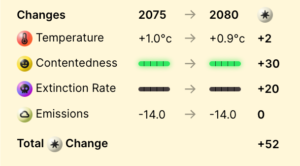
The word “prosperous” seemed odd, since it typically implies material abundance. According to the game, energy usage in 2080 was slightly more than it was in 2022. By contrast, I envision energy usage rapidly declining worldwide and quite drastically in richer regions. Even though the game assumes money has been abolished (as explained on the back of the “Crack down on crypto-mining” card), the designers strangely chose to make a dollar sign the symbol for living standards. They also retain the language of economic “development,” introduced into policymaking by President Harry Truman. Doing so, and by linking world happiness with material wealth, the game’s designers ignore the strong critique that various Global South movements and intellectuals have launched against the development discourse and its generally implicit assumption that the whole world should conform to the obscene affluence of the North.
Moreso than the game’s designers, I see an urgent need to radically define our understanding of “living standards” (if we hold onto that term at all), abandoning the aspiration for private wealth and instead striving for strong communities, varied experiences, and forms of public affluence such as parks, museums, libraries, cafeterias, and theaters. The dollar sign is practically the antithesis of what we should strive for, and achieving a livable future would be more doable if we replaced the goal of “prosperity” with the South’s alternatives of buen vivir (living well), ubuntu (humanness), and swaraj (self-governance).
When I tried replaying the same steps in the game, I was consistently able to win by 2080, with warming lowering at that date to 0.9 degrees. Because the game includes a chance-based distribution of political-capital points, it wasn’t always possible to implement everything in the exact same order. But if there wasn’t enough points to implement a solution in one round, it usually didn’t make a difference if I waited to implement it in the next round.
Various playthroughs labeled me as all the tendencies I’d expect (Animal Liberationist, Ecofeminist, Environmentalist, Fanonist, Utopian). Although I don’t mind the support of the game’s fictitious political parties, I see any parliamentary focus as a dead end in real life. The state, inherently an elitist institution, brings out the most elitist tendencies of whatever parties take power. It’s invariably the moderate “realos” who win out over the radical “fundis” once real-life Green Parties assume state power. Fanon aptly warned about the colonized population’s national bourgeoisie which, after seizing power in a statist revolution, accepts a neocolonial role and “turns its back on the general population.” As I further argue in my upcoming review of the Half-Earth Socialism book, I can’t share the authors’ enthusiasm for state planning.
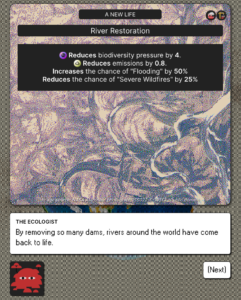
In fact, the greenest path would be to dismantle the state as quickly as possible. There’d likely be no need to “Restrict air travel” or “Mandate vegetarianism” (two of the game’s cards) if there weren’t a state that arrested eco-activists who blocked runways, slashed plane tires, rescued animals from farms, and helped Indigenous communities reclaim their territories from cattle ranchers. Without a state enabling capitalists to hoard the world’s wealth, it’s unlikely that there’d be enough desperate workers to keep industrial slaughterhouses in operation.
A prominent eco-Marxist was once trying to convince me of the necessity for a state, and he said something like “I can’t see anarchists running airports.” Though I can imagine an anarchist-run airport just fine (such as the one envisioned in Albert and Hahnel’s Looking Forward), I don’t see why we’d want such a thing. If an anarchist society couldn’t fly airplanes, that’s a good thing! Let’s shut the airports down. Maybe solar-powered aircraft will one day be a viable option. But until then, there’s no reason why people in an anti-capitalist world couldn’t travel slowly, relaxing and enjoying the scenery on buses, trains, and boats. After all, there would be no full-time jobs for which we’d need to urgently return. Ditto to David Harvey’s complaint that anarchists couldn’t run nuclear power stations. A Libcom article shows how anarchists could theoretically run nuclear power plants far more safely and effecitvely than capitalists do, but I honestly wouldn’t mind Harvey being right. If anarchists can’t run nuclear power plants, that’s all the more reason for anti-nuclear advocates like myself to call for anarchy.
When the Earth Liberation Front showed up in the game, I cheered at first. If I were a state planner (heaven forbid!), I would welcome the ELF as a radical flank and an ally in dismantling ecocidal infrastructure. But the game’s version of the ELF only slows down the ecological transition, by lowering “world contentedness” and thus impeding your ability to phase out polluting industries. When the ELF attacks in the game, there’s no corresponding decrease of species extinction or of greenhouse gas emissions. Seeing the ELF portrayed as a hindrance in Marxists’ video game couldn’t help but reinforce my conviction that states and central planning won’t protect the Earth. I thought of real-life examples of self-proclaimed socialists repressing ecologically-oriented movements: Bolsheviks attacking revolutionary peasants during Russia’s civil war, France’s Socialist government sinking Greenpeace’s Rainbow Warrior ship in 1985, Bolivia’s Socialist state cracking down on Guaraní land defenders in 2015, Cuba’s Communist state torturing and extraditing former ELF militant Joseph Dibee in 2018.

To the developers’ credit, they agreed to correct a mistake I pointed out to them. They had falsely attributed a Mexican ecofascistic group’s slogan “misanthropy and wild nature, always” to the ELF. Far from being misanthropic, the real-life ELF advocates “Animal, Human, and Earth Liberation” and supports anarchist and Indigenous struggles against capital. The image may already be corrected by now.
Maybe the game isn’t far off by associating me with followers of Frantz Fanon who saw anti-colonial violence as a psychological antidote to the “passive and despairing attitude” of the colonized. Although he wrote these words in the context of Algeria’s independence struggle, I think his insights can be applied to some extent even throughout the Global North. Capital has so thoroughly colonized everyday life that we tend to see commodification as inevitable and equality as unimaginable. In this context, I have to agree with those anarchists and critical theorists who say there’s a need for (joyful) militancy to break the spell of complacency.
I don’t wish to advocate violence unless it’s necessary (the key word in Fanon’s phrase later popularized by Malcolm X), but I do see a dire need for property destruction, monkeywrenching, house visits, and whatever else it might take to radicalize the population and give the Earth a fighting chance. As I conclude this essay, I’m getting ready to write and send letters to incarcerated eco-strugglers. I’d encourage you to do the same by following the instructions on the Earth First! Journal website. If we’re serious about advocating for an ecological revolution, we need to be willing to support the courageous folks who kickstarted the process.
I look forward to reading what results others receive in the Half-Earth Socialism video game. The game is a fun thought experiment that will get people thinking, dreaming, and envisioning. Here are the steps I took on May 25 that achieved the outcome I’ve been describing.
2022
1.1 degrees, 42.9 Gt, 48% land used, 108 PWh
Production
Electricity: 15 Hydropower, 5 Solar, 80 Wind
Fuel: 40 Biofuels, 20 Natural gas, 40 Petroleum (1 planning cycle to complete, decreases emissions by 6%).
Crops: 55 Industrial, 45 Smallholder
Policies
Utopian curriculum, Universal family planning, Marine protected areas, Factory farm reform, Ecofeminist curriculum, Animal liberationist curriculum
Infrastructure
1 to Compost, Electrify road transport, Energy conservation campaign, Expand public transit, Expand recycling, Indigenous sovereignty, Passive building mandate and retrofit, Pedestrian and bike-friendly city, Remediate and protect ecosystems
Research
2 to Green hydrogen
1 to High-density batteries
2025
1.4 degrees, 35.7 Gt, 54% land used, 112 PWh
Production
55 Industrial, 5 Organic ag, 40 Smallholder farms
Electricity is now 0% nuclear.
Policies
Vegetarian mandate, Feminist science and technology studies, Fanonist curriculum
Infrastructure
1 to Food waste campaign, Regenerative agriculture
Research
Ecosocialist video game
2030
1.5 degrees, 27.1 Gt, 29% land used, 115 PW
Fuel: 25 Biofuel, Green 75 Hydrogen (3 planning cycles to complete)
Crops: 55 Industrial, 10 Organic, 35 Smallholder
Policies
Masculinity de-tox
Infrastructure
1 to Battery storage network, Esperanto, Green roofs, Multistrata agroforestry, Reconcile town and country
Research
1 to Alternative refrigerants, Drought-resistance crops, Electric-arc furnace, Floating wind turbines
2 to High-density batteries, Perennial cereals
3 to Reintroduce apex predators, Cellular meat
6 to Next-gen solar PV
2035
1.5 degrees, 12.2 Gt, 29% land used, 139 PWh
Production
Electricity: 10 Solar, 90 Wind
Fuel: 100 Green Hydrogen
100 Cellular meat (4 planning cycles to take effect)
65 Organic ag, 35 Smallholder farms
Policies
Vegan mandate, Meatless Mondays, Environmentalist curriculum, Ban high-seas fishing, Ban cars, Abolish prisons
Infrastructure
1 to Continental smart grid, Expand nature preserves, Sewage treatment plants
2040
1.4 degrees, 1.4 Gt, 23% land used, 134 PWh
Production
Electricity: 15 Floating wind, 75 Solar, 10 Wind
Crops: 70 Organic, 30 Smallholder
All electricity is now from solar and wind.
Policies
Energy quotas, Ban outdoor cats, Abolish zoos
Infrastructure
1 to Coastal wetland protection and remediation, Mass electrification, Phase out commercial fishing
3 to Food waste campaign
2045
1.4 degrees, -9.8 Gt, 21% land used, 121 PWh
Policies
Degrowth in developed regions, Flexitarian, Restrict air travel, Rien faire comme une bete
Infrastructure
5 to Global demilitarization
2050
1.4 degrees, -11.1 Gt, 21% land used, 89 PWh
Fuel is now 100% green hydrogen
Crops are 100% non-industrial
Policies
Crack down on crypto-mining, Champagne socialism, Ban non-Indigenous hunting, Ban exotic animal trade
Infrastructure
6 to Global demilitarization
Research
1 to Green container ships, Advances in ecosystem modelling, Long-range electric aviation
2055
1.3 degrees, -13.5 Gt, 21% land used, 106 PWh
Production
Animal protein is 100% from cellular meat.
Infrastructure
2 to Continental smart grid
Research
9 to Green container ships, Long-range electric aircraft
1 to Advances in ecosystem modelling
2060
1.2 degrees, -13.3 Gt, 22% land used, 116 PWh
2065
1.2 degrees, -13.3 Gt, 221% land used, 120 PWh
2070
1.1 degrees, -12.8 Gt, 21% land used, 124 PWh
2075
1 degrees, -14 Gt, 22% land used, 127 PWh
2080
0.9 degree, -14 Gt


The developers have apparently updated the model based on increasingly alarming climate news. With the parameters established above, it seems no longer possible to avoid overshooting 1.5 C and to consistently get below 1 C by 2085. However, it’s still possible to peak at 1.6 C and return to 1.2 C by 2085, presumably to continue decreasing to 1 C by the century’s end. The following’s from yesterday, March 27th.
2022
1.1 degrees, 51.6 Gt emission, 49% land used, 115 PWh energy use
Production
Electricity: 80 Solar, 20 Wind
Fuel: 20% natural gas, 80% petroleum
Crops: 45% Industrial, 10% Organic, 45% smallholder
Research
2 to Green hydrogen
1 to Cellular meat, High-density batteries, Next-gen solar PV
Infrastructure
1 to Battery storage network, Energy conservation campaign, Expand public transit, Expand recycling, Indigenous sovereignty, Passive building mandate and retrofit, Pedestrian and bike-friendly cities, Remediate and protect ecosystems
Policies
Utopian curriculum, Marine protected areas, Factory farming reform, Animal liberationist curriculum
2025
1.4C, 42.4 Gt, 54% land used, 123 Pwh
Production
Fuel: 100% Petroleum
Crops: 60% Organic, 40% Smallholder
Research
1 to Ecosocialist video game
Infrastructure
1 to Compost, Reconcile town and country
Policies
Vegetarian mandate, Ban high-seas fishing
2030
1.5 C, 38.4 Gt, 28% land used, 133 PWh
Production
Fuel: 100% Green Hydrogen
Crops: 65% Organic, 35% Smallholder
(Electricity is now nuclear-free)
Infrastructure
2 to Esperanto
1 to Expand nature preserves, Food waste campaign, Green roofs, Phase out commercial farming, Regenerative agriculture
2035
1.5 C, 29.9 Gt, 32% land used, 167 PWh
Production
Crops: 70% Organic, 30% Smallholder
Livestock: 100% cellular meat
Research
1 to Electric-arc furnaces, Perennial cereals, Reintroduce apex predators
Infrastructure
1 to Coastal wetland protection and restoration, Continental smart grid
Policies
Vegan mandate, Energy quotas
2040
1.6 C, 15.4 Gt, 30% land used, 225 PWh
Production
(Electricity is nuclear- and fossil-free)
Policies
Universal family planning
Infrastructure
1 to Mass electrification, Restore desert habitats, Sewage treatment plants
2045
1.5 C, -3.3 Gt, 27% land used, 169 PWh
Production
Electricity: 100% solar.
Crops: 60% Organic, 40% Smallholder
Research
Green container ships, Alternative refrigerants, Long-range electric aviation
Infrastructure
8 to Global demilitarization
1 to Mass electrification
Policies
Rein faire comme une bete, Restrict air travel, Fanonist curriculum, Environmentalist curriculum, Ecofeminist curriculum, Degrowth in developed regions, Crack down on crypto-mining, Ban outdoor cats, Ban cars
2050
1.5 C, -5.7 Gt, 25% land used, 122 PWh
Crops: 65% Organic, 35% Smallholder
(Fuel is fossil-free)
Research
1 to Advances in Ecosystem modeling
Infrastructure
3 to Multistrata agroforestry
Policies
Abolish prisons, Flexitarian, Masculinity de-tox
2055
1.6 C, -8.9 Gt, 24% land used, 120 PWh
Production
Crops: 60% Organic, 35% Smallholder
(Animal agriculture is abolished. Remaining animal protein, 6 units compared to 73 in 2022, is all from cellular meat).
Research
2 to Green container ships, Alternative refrigerants, Drought-resistant crops
Policies
Abolish prisons, Ban exotic animal trade, Ban non-Indigenous hunting, Champagne socialism, Feminist science and technology studies
Infrastructure
3 to Multistrata agroforestry
2060
1.5 C, -9.1 Gt, 23% land used, 119 PWh
Research
7 to Drought-resistant crops
2065
1.5 C, -9.0 Gt, 23% land used, 122 PWh
2070
1.4 C, -9.5 Gt, 23% land used, 123 PWh
2075
1.3 C, -9.5 Gt, 23% land used, 123 PWh
2080
1.3 C, -9.5 Gt, 23% land used, 123 PWh
2085:
1.2 C, -9.4 Gt
Thanks for finally writing about > Planning for Prosperity?
– New Politics < Liked it!